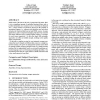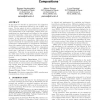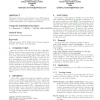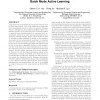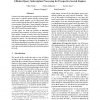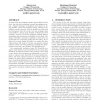WWW
2006
ACM
15 years 10 days ago
2006
ACM
By supplying different versions of a web page to search engines and to browsers, a content provider attempts to cloak the real content from the view of the search engine. Semantic...
WWW
2006
ACM
15 years 10 days ago
2006
ACM
While much of the data on the web is unstructured in nature, there is also a significant amount of embedded structured data, such as product information on e-commerce sites or sto...
WWW
2006
ACM
15 years 10 days ago
2006
ACM
In this paper we describe an approach for the verification of Web service compositions defined by sets of BPEL processes. The key aspect of such a verification is the model adopte...
WWW
2006
ACM
15 years 10 days ago
2006
ACM
We introduce and evaluate a middleware clustering technology capable of allocating resources to web applications through dynamic application instance placement. We define applicat...
WWW
2006
ACM
15 years 10 days ago
2006
ACM
This paper provides a novel approach to use URI fragment identifiers to enable HTTP clients to address and process content, independent of its original representation. Categories ...
WWW
2006
ACM
15 years 10 days ago
2006
ACM
A social network can become bases for information infrastructure in the future. It is important to extract social networks that are not biased. Providing a simple means for users ...
WWW
2006
ACM
15 years 10 days ago
2006
ACM
Large-scale text categorization is an important research topic for Web data mining. One of the challenges in large-scale text categorization is how to reduce the amount of human e...
WWW
2006
ACM
15 years 10 days ago
2006
ACM
As the popularity of the web increases and web applications become tools of everyday use, the role of web security has been gaining importance as well. The last years have shown a...
WWW
2006
ACM
15 years 10 days ago
2006
ACM
Current web search engines are retrospective in that they limit users to searches against already existing pages. Prospective search engines, on the other hand, allow users to upl...
WWW
2006
ACM
15 years 10 days ago
2006
ACM
As most blogs and traditional media support RSS or Atom feeds, the news feed technology becomes increasingly prevalent. Taking advantage of ubiquitous news feeds, we design FeedEx...

